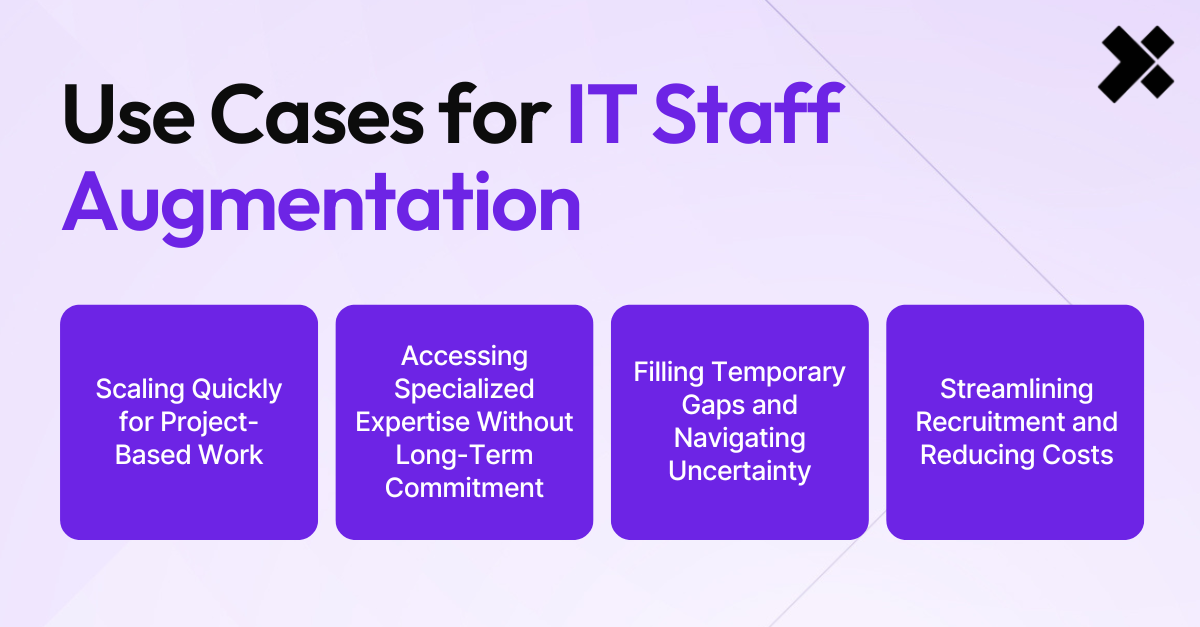
You’ve got a project that’s too big for your team to handle alone—and the clock is ticking. The traditional hiring process isn’t built for crunch time, but there’s another way: IT staff augmentation. It’s a fast, flexible solution that brings in skilled talent on a temporary basis, giving your team the boost it needs to finish critical projects without missing a beat.
The demand for IT staff augmentation is skyrocketing, and it’s no surprise. The relentless pace of technological change, the rise of remote work, and the surging popularity of artificial intelligence have left tech leaders scrambling to keep up. When deadlines loom and demand spikes, you need a way to scale—now.
The numbers back it up. According to ManpowerGroup, IT continues to top the list of in-demand roles, with companies around the world competing fiercely for available talent. In 2025, IT staff augmentation is projected to become an $82 billion industry, growing steadily at 3.5% annually.
Let’s break down everything you need to know about IT staff augmentation: what it is, when it’s the right choice, how it compares to other staffing options, and how to get started. Plus, we’ll show you how to leverage on-demand talent that integrates quickly, delivers results, and stays engaged for the long haul.
What Is Staff Augmentation? (Staff Augmentation Meaning)
Staff augmentation is a dynamic way to expand your team’s capabilities by bringing in external talent with specific skill sets when and where you need it. Instead of navigating a lengthy hiring process on your own, you get immediate access to experts while maintaining full control over the work they do, how they do it, and when it gets done.
This approach is a game-changer for businesses that need to stay agile. Whether you’re chasing tight deadlines, tackling complex projects, or scaling up to meet demand without committing to long-term hires, staff augmentation lets you adapt without compromising on quality.

Use Cases for IT Staff Augmentation
IT staff augmentation is more than a temporary fix—it’s a versatile strategy that empowers your team to stay agile, efficient, and focused on what matters most. Whether you’re tackling growth challenges, filling critical skill gaps, or navigating short-term demands, staff augmentation offers a flexible way to bring the right talent into your team when you need it most. Here’s how it can help.
Scaling Quickly for Project-Based Work
Deadlines, unexpected workload increases, or rapid growth can push even the most capable teams to their limits. IT staff augmentation allows you to scale efficiently by bringing in skilled professionals to handle increased demands without committing to long-term hires.
This flexibility is especially useful for fast-growing startups or enterprises tackling time-sensitive projects. With the right external talent, you maintain momentum, avoid burnout, and deliver on time without overextending your core team.
Accessing Specialized Expertise Without Long-Term Commitment
Sometimes your projects require niche expertise your team doesn’t have in-house. Hiring a full-time specialist for a one-off task or short-term project isn’t always feasible. Staff augmentation bridges this gap, connecting you with experts who can deliver exactly what you need, when you need it.
This approach also lets you tap into a global talent pool, increasing your chances of hiring an AI developer, for example.
Filling Temporary Gaps and Navigating Uncertainty
Employee absences, such as parental leave or unplanned departures, can disrupt workflows and derail timelines. Staff augmentation offers a rapid-response solution to these gaps, ensuring your projects stay on track while maintaining team productivity.
It’s equally effective for navigating periods of uncertainty, such as seasonal spikes in demand or temporary shifts in business priorities. By scaling up or down as needed, you stay adaptable without having to hire full-time employees.
Streamlining Recruitment and Reducing Costs
Traditional hiring is time-intensive and expensive, especially in competitive labor markets. Staff augmentation simplifies this process by providing pre-vetted professionals who can integrate with your team immediately.
This is particularly helpful for companies managing high turnover or struggling to project demand. By sidestepping the lengthy recruitment process, you save on operational costs while still getting the high-caliber talent you need to succeed.

6 Common Types of IT Staff Augmentation
IT staff augmentation offers flexible ways to address your team’s unique needs, whether scaling quickly, filling skill gaps, or tackling high-stakes projects. Here’s how different types of staff augmentation models help teams reach their goals.
Commodity Augmentation: Extra Hands for Repetitive Work
When your project demands more hands for straightforward, repetitive tasks, commodity augmentation provides the support you need. Perfect for high-volume work like system testing or data migration, it allows your core team to focus on high-priority goals while meeting tight deadlines efficiently.
Skill-Based Staff Augmentation: Filling Targeted Gaps
Skills staff augmentation brings in professionals with specific abilities to handle intermediate-level tasks. It’s ideal for projects that require targeted technical skills without necessarily needing senior-level expertise. This approach is flexible, efficient, and cost-effective.
Specialist Augmentation: Expertise for High-Stakes Projects
For complex, business-critical projects, specialist augmentation connects you with seasoned experts. These professionals bring advanced technical knowledge to lead initiatives like AI development, cloud migration, or system overhauls, ensuring your team has the expertise to deliver on ambitious goals.
Offshore Augmentation: Accessing Global Talent
Offshore software development expands your reach to a global talent pool, often in cost-efficient regions. This model is ideal for routine or ongoing work that doesn’t require real-time collaboration, allowing you to maximize your budget without compromising on quality.
Nearshore Augmentation: Balancing Cost and Collaboration
For smoother integration and easier communication, nearshore staff augmentation focuses on sourcing talent from neighboring regions. It offers many of the cost advantages of offshoring while minimizing time zone and cultural barriers, making it a strong option for collaboration-heavy projects.
Onshore Augmentation: Seamless Local Integration
When cultural alignment, shared time zones, or in-person collaboration are crucial, onshore augmentation delivers local talent who can integrate easily with your existing team. This approach is particularly effective for high-touch projects requiring close teamwork and frequent real-time communication.

IT Staff Augmentation Services vs. Other Staffing Models
When building a team to tackle complex IT projects, there are several staffing models to consider: full-time hiring, independent contractors, managed services, project outsourcing, and staff augmentation. Each has its strengths and weaknesses, but staff augmentation often strikes the perfect balance between flexibility, control, and access to specialized talent. Here’s how it stacks up against other approaches, along with its potential challenges and how to address them.
Flexibility and Scalability
Staff augmentation shines when you need to quickly scale your team to meet fluctuating project demands. Unlike full-time hiring, which locks you into long-term commitments, staff augmentation allows you to add talent only for the duration of a project. Similarly, it’s more agile than managed services or outsourcing, which often operate within predefined scopes of work.
However, this flexibility requires careful integration to avoid disruption. Resistance from in-house teams or unclear roles can hinder productivity. Strong project management and clear communication helps smooth the transition.
Access to Specialized Talent
Staff augmentation provides access to a global talent pool of software developers, making it easier to hire software engineers with niche expertise for critical projects. Compared to full-time hiring, where the talent pool is often limited by geography, and independent contractors, who may juggle multiple clients, augmented staff are dedicated to your project and selected for their technical and cultural fit.
That said, quality control can be a challenge if the vetting process isn’t thorough. Partnering with a reputable provider ensures you get candidates with both the technical skills and cultural alignment your project requires.
Cost Efficiency Without Sacrificing Control
Augmented staff align costs directly with project budgets. Unlike full-time hires, there’s no need to pay for benefits, training, or long-term employment expenses when you augment talent. It’s also often more cost-effective than outsourcing an entire project to another company, which can come with higher overhead and less direct oversight.
Still, over-reliance on external talent can lead to a loss of institutional knowledge. To mitigate this, document workflows and best practices to ensure long-term benefits from the work done by augmented staff.
Greater Control Over Projects
One of the major advantages of staff augmentation vs managed services is the control it gives you over day-to-day operations. Augmented staff integrate directly into your workflows, allowing you to oversee their contributions and maintain alignment with your goals.
However, retaining control means you’re responsible for clear communication and ensuring team alignment. Miscommunication, particularly with remote staff across time zones or cultural barriers, can disrupt progress. Establishing intentional communication practices, such as regular updates and clearly defined expectations, ensures the team stays on track.
Streamlined Onboarding and Reduced Administrative Burden
Staff augmentation providers handle much of the administrative burden, including payroll, compliance, and benefits. This reduces your HR workload compared to full-time hiring or managing contractors. Onboarding is also faster, with augmented staff often ready to integrate into your team immediately.
However, compliance and legal obligations still require attention. Make sure contracts clearly define scopes of work, payment terms, and responsibilities. Consulting with legal counsel can further minimize risks.

How to Choose the Right Staff Augmentation Partner
Staff augmentation isn’t just about finding extra hands to help—it’s about building a strategic partnership that adds value to your team. The right staff augmentation company should seamlessly integrate with your goals, help you scale efficiently, and maintain high performance. Here’s what to focus on when evaluating your options.
Proven Expertise
When vetting a provider, look for evidence of success in your industry. This could include case studies, client testimonials, or specific examples of how they’ve tackled challenges similar to yours. Focus on how their talent has delivered results, whether it’s meeting tight deadlines, managing complex integrations, or solving niche technical problems.
It’s also worth discussing their vetting process. A thorough screening for both technical skills and domain knowledge ensures that the people you’re adding to your team are ready to contribute effectively from day one.
Scalability and Flexibility
Staff augmentation is built on the promise of flexibility, but not all providers deliver on that promise equally. Start by clearly defining your current and projected needs, then ask how a provider can scale resources up or down as those needs evolve.
An important consideration is the onboarding process. A solid provider will have a framework to ensure new team members integrate quickly, syncing with your workflows, tools, and communication style. This is particularly critical for remote teams, where a smooth start can make all the difference in maintaining project momentum.
Cultural Alignment
Cultural fit is a key factor in how well an augmented team integrates with your own. Developers who align with your values and working style can start contributing faster and more effectively.
Ask potential providers about their approach to assessing cultural alignment. A good partner will have processes in place to match candidates to your team’s ethos. This will ensure technical compatibility, as well as a shared mindset that fosters collaboration.
Investment in Talent Development
The best staff augmentation providers don’t just deliver talent; they develop it. Look for evidence of ongoing training, certifications, and professional development initiatives. These efforts keep their talent pool sharp, motivated, and equipped to handle emerging challenges.
Retention rates are another useful indicator. Providers with strong retention rates likely offer an environment that fosters both loyalty and growth, which can translate to better outcomes for your projects. Developers who stay engaged and build domain expertise over time become invaluable assets.
Scale Effortlessly with X-Team’s IT Staff Augmentation Solutions
When you need to expand your team—whether it’s a single developer or a fully integrated, on-demand team—X-Team delivers rigorously vetted talent that seamlessly aligns with your workflows and culture. Our software engineers are ready to contribute from day one, empowering your business to scale with agility and confidence.
At X-Team, we simplify the challenges of IT staff augmentation so you can stay focused on achieving your goals. Our human-driven approach ensures a streamlined hiring process, quicker onboarding, and seamless integration into your team. The result? High-performing teams that drive innovation, meet deadlines, and keep you moving forward.
Need elite software engineers on demand? Discover how X-Team can power your next stage of growth!
Frequently Asked Questions
IT Staff Augmentation
What is IT staff augmentation?
IT staff augmentation is a hiring model that allows you to temporarily extend your in-house team with external, highly skilled developers. It’s a fast, flexible way to fill skill gaps, hit deadlines, and scale up or down without long-term commitments.
How is staff augmentation different from traditional outsourcing?
With outsourcing, you hand off an entire project to an external team. Staff augmentation, on the other hand, integrates external talent into your existing workflows—so you keep control, maintain alignment, and move faster with the right expertise on hand.
When should I consider using staff augmentation?
Staff augmentation is ideal when you need to:
-
Scale quickly for a time-sensitive project
-
Fill temporary gaps due to leave or turnover
-
Bring in niche expertise
-
Avoid the delays and costs of traditional hiring
-
Boost team productivity without long-term overhead
How does X-Team ensure quality and cultural fit?
X-Team’s meticulous, human-led vetting process prioritizes both technical excellence and cultural alignment. Our developers don’t just have the skills—they integrate seamlessly into your team and stay motivated long-term.
Can IT staff augmention work in different time zones?
Absolutely. X-Team’s engineers are distributed globally and trained in time zone-agnostic collaboration. Whether you need real-time overlap or asynchronous progress, we align with your communication style to keep things moving forward.
What industries benefit most from IT staff augmentation?
While any tech-driven business can benefit, staff augmentation is especially valuable in fast-paced industries like gaming, media, fintech, and SaaS—where time to market and innovation are non-negotiable.
What is IT staff augmentation?
IT staff augmentation is a hiring model that allows you to temporarily extend your in-house team with external, highly skilled developers. It’s a fast, flexible way to fill skill gaps, hit deadlines, and scale up or down without long-term commitments.
Is IT staff augmentation cost-effective compared to full-time hiring?
Yes. Staff augmentation avoids the costs of recruitment, onboarding, benefits, and long-term employment. You only pay for the talent you need, when you need it—without sacrificing quality or control.
TABLE OF CONTENTS



